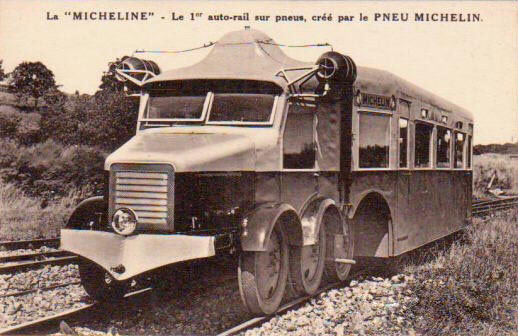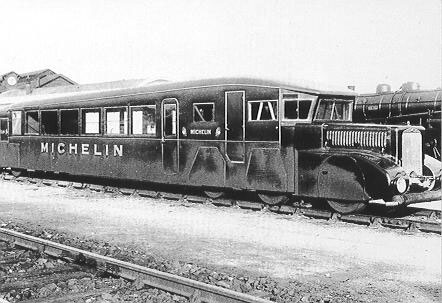Railroads Adopt Pneumatic Tires to Reduce Suspension Losses

April 1, 2013: Recent tests with bicycles have shown that even on a very smooth road surface, lower tire pressures increase comfort with no loss of speed (Bicycle Quarterly Spring 2013). Now even railroads have become persuaded that super-hard tires diminish both comfort and performance.
Railroads are investigating how to replace their steel tires with supple pneumatic tires that run at relatively low pressures. “We may be a bit late to the party, but more than a century after bicycles adopted pneumatic tires, railroads are finally ready to follow suit,” explained John Hardcase, of the Union Pacific Railroad. “The potential for energy savings due to reduced suspension losses is significant. As important is the improved comfort, not just for passengers, but also resulting in fewer damages to freight.”
Michelin has built a prototype railcar with pneumatic tires that is undergoing tests on an abandoned rail line near Saint-Etienne in Central France (photo above). “It’s not a coincidence that we are testing this right where Vélocio discovered the advantages of supple, wide tires for bicycles during the 1920s,” said Jean-Claude Bibendum of the Michelin company. “For decades, cyclists have tried to approximate a steel railroad wheel by inflating their tires to the maximum pressure, thereby reducing the suspension effect to a minimum. Now it has become clear that this approach has no benefits. Even professional bicycle racers are running their tires at lower pressures to reduce suspension losses. It’s time for railroads to re-examine their tire choices as well. Steel tires on railroad wheels may soon be a thing of the past.”
The company has found that supple casings are key to realizing the advantages of pneumatic tires on railroads. So far, punctures have not been a problem. Mr. Bibendum: “The vibrations of the approaching train, while much-reduced compared to steel-tired trains, still are sufficient to cause debris placed on the rail to fall off to the sides. We also use multiple wheels to prevent derailments in case of a puncture. We are investigating whether multiple wheels could be used on bicycles to prevent a loss of control when a tire suddenly deflates.”
For Michelin’s newly founded railroad division, the next step is a streamlined train (below) that will be tested on France’s high-speed TGV network. For cyclists, there may be interesting synergies as a result of the collaboration with railroads. (© April 1, 2013)



